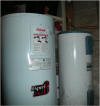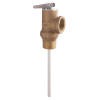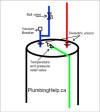If your hot water isn’t as hot as it used to be or your electric bill is taking a beating, you might want to replace your old hot water tank for a modern energy efficient one. Although this may be a big job for some, it is possible for a homeowner to accomplish with the help of this guide and a few simple tools.
taking a beating, you might want to replace your old hot water tank for a modern energy efficient one. Although this may be a big job for some, it is possible for a homeowner to accomplish with the help of this guide and a few simple tools.
The average life expectancy of a hot water tank is around ten years so if your concerned about your hot water tank leaking then it’s time to replace it, a leak could cost you thousands.
*Plumbing codes vary, always consult your local authority for current code requirements in your area.
Determining Your Hot Water Needs
Most homes use a 40 gallon hot water tank which will supply enough hot water for the average family of four, but if your not the average family the are other options. Here is a general guide:
2 people 30 gallon tank 3-4 people 40-50 gallon tank 5-6+ people 60-80 gallon tank
There are also tankless water heaters available that will only heat the water as there is a demand for it, this can save you money by not keeping a large volume of water hot when it’s not required.
Tools And Materials You May Require
Soldering equipment
Large adjustable wrench
Pipe cutter
Small pipe wrench (14″)
2 Couplings
Pliers
3/4″ pipe (1/2″ pipe if that’s what you have installed already)
Tape measure
3/4″ tee
3/4″ 90 degree elbows x 3-4
3/4″ Male adapter x 1
3/4″ female adapter x 1
Garden hose
Volt meter
Teflon tape
1 x 3/4″ ball valve
Safety – Goggles, gloves, fire extinguisher or bucket of water
Bucket
Multi-tip screwdriver
Rags
Vacuum breaker
Wire nuts / marrets
 3/4″ Temperature & Pressure relief valve (if not already installed on the tank)
3/4″ Temperature & Pressure relief valve (if not already installed on the tank)
 2 x Dielectric Unions
2 x Dielectric Unions
Removing The Old Hot Water Tank
*Ensure the electrical disconnect or breaker is off and test with a volt meter.
- Turn off the water supply to the tank. You may wish to let the water cool for a couple hours, but it isn’t necessary to.
- Attach a garden hose to the drain at the bottom of the tank and run it to a floor drain. If you don’t have a floor drain you can use a sump pit, laundry tub or bucket by bucket if necessary. I use a small pump that has 3/4″ hose treads on it.
- Start to drain the water by relieving the pressure with the temperature and pressure valve, just lift the metal lever until it stays open.
- Use a pipe cutter to cut the hot and cold lines to the tank. Place a bucket under to catch any water coming out.
- Remove the electrical panel and test the wires for current with a volt meter (safety first). Disconnect the wires from the tank and keep the box connector for reuse. Pay attention to how they are connected for reference.
- Do not reuse the temperature and pressure relief valve or vacuum breaker from the old tank.
- Tip – A fridge cart will make the tank much easier to get out of the house.
Installing The New Hot Water Tank
-
 Begin by placing the new tank into position so that the drain and electrical panel will face an accessible direction.
Begin by placing the new tank into position so that the drain and electrical panel will face an accessible direction. - Install the T&P valve (temperature and Pressure) and the bottom galvanized section of the dielectric unions using teflon tape on the threads of the hot and cold inlets and T&P valve.
- Install the vacuum breaker on the cold line as shown in the diagram.
- *SAFETY* – Connect the discharge from the T&P valve using the same size pipe as the outlet and bring the pipe to within 6 inches of the floor.
- Reconnect all piping to the existing lines.
- Do not install a valve on the hot water line from the tank, this could cause an explosion if the tank ever malfunctioned while the valve was closed. See it on Mythbusters via YouTube.
- Open the electrical cover plate and and connect the wires. Marret the red to red, the black to black and the green wire to the metal frame of the tank.



- Fill the tank and check for leaks before powering up the hot water tank. You will have to open the T&P valve to release the air pressure while the tank fills.
- Turn on the power and wait for a well deserved hot shower.
